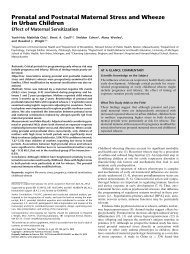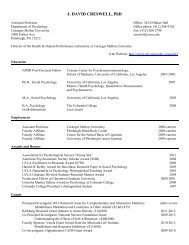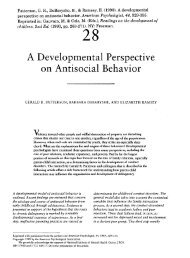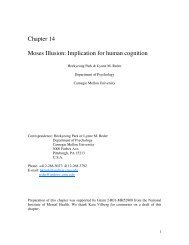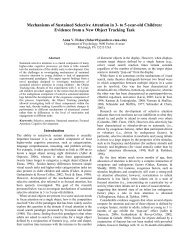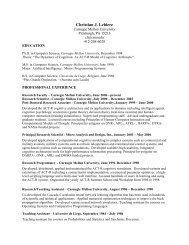Does women's greater fear of snakes and spiders originate in infancy?
Does women's greater fear of snakes and spiders originate in infancy?
Does women's greater fear of snakes and spiders originate in infancy?
Create successful ePaper yourself
Turn your PDF publications into a flip-book with our unique Google optimized e-Paper software.
1 Orig<strong>in</strong>al Article<br />
2 <strong>Does</strong> <strong>women's</strong> <strong>greater</strong> <strong>fear</strong> <strong>of</strong> <strong>snakes</strong> <strong>and</strong> <strong>spiders</strong> <strong>orig<strong>in</strong>ate</strong> <strong>in</strong> <strong>in</strong>fancy? ☆<br />
3 David H. Rakison ⁎<br />
4 Department <strong>of</strong> Psychology, Carnegie Mellon University, Pittsburgh, PA 15213, USA<br />
5 Initial receipt 26 September 2008; f<strong>in</strong>al revision received 3 June 2009<br />
6 Abstract<br />
7 Previous studies with adult humans <strong>and</strong> nonhuman animals revealed more rapid <strong>fear</strong> learn<strong>in</strong>g for <strong>spiders</strong> <strong>and</strong> <strong>snakes</strong> than for mushrooms<br />
8 <strong>and</strong> flowers. The current experiments tested whether 11-month-olds show a similar effect <strong>in</strong> learn<strong>in</strong>g associative pair<strong>in</strong>gs between facial<br />
9 emotions <strong>and</strong> <strong>fear</strong>-relevant <strong>and</strong> <strong>fear</strong>-irrelevant stimuli. Consistent with the <strong>greater</strong> <strong>in</strong>cidence <strong>of</strong> snake <strong>and</strong> spider phobias <strong>in</strong> women, results<br />
10 show that female but not male <strong>in</strong>fants learn rapidly to associate negative facial emotions with <strong>fear</strong>-relevant stimuli. No difference was found<br />
11 between the sexes for <strong>fear</strong>-irrelevant stimuli. The results are discussed <strong>in</strong> relation to <strong>fear</strong> learn<strong>in</strong>g, phobias, <strong>and</strong> a specialized evolved <strong>fear</strong><br />
12 mechanism <strong>in</strong> humans.<br />
13 © 2009 Elsevier Inc. All rights reserved.<br />
14<br />
15 Keywords: Infancy; Fear; Snakes; Spiders; Sex differences; Cognition<br />
16<br />
17 1. Introduction<br />
Evolution <strong>and</strong> Human Behavior xx (2009) xxx–xxx<br />
18 The evolved function <strong>of</strong> <strong>fear</strong> is to organize responses<br />
19 when confronted with a particular k<strong>in</strong>d <strong>of</strong> adaptive problem,<br />
20 namely, danger. Over evolutionary time, specific dangers<br />
21 were recurrent, <strong>and</strong> there would have been <strong>in</strong>tense selection<br />
22 pressure for the emergence <strong>of</strong> psychological mechanisms<br />
23 that facilitate <strong>fear</strong> learn<strong>in</strong>g for them (Öhman & M<strong>in</strong>eka,<br />
24 2001). Two recurrent dangers to humans from other species<br />
25 throughout human <strong>and</strong> primate evolution were <strong>spiders</strong> <strong>and</strong><br />
26 <strong>snakes</strong> (Öhman & M<strong>in</strong>eka, 2003). Fear <strong>of</strong> these nonhuman<br />
27 animals is common <strong>in</strong> adults <strong>and</strong> children, <strong>and</strong> they elicit<br />
28 phobias <strong>in</strong> approximately 5.5% (<strong>snakes</strong>) <strong>and</strong> 3.5% (<strong>spiders</strong>)<br />
29 <strong>of</strong> the population (Fredrikson, Annas, Rischer, & Wik,<br />
30 1996). Moreover, there is a consistent sex difference <strong>in</strong> the<br />
31 <strong>in</strong>cidence <strong>of</strong> snake <strong>and</strong> spider phobias; women are four times<br />
32 more likely than men to have <strong>fear</strong>s <strong>and</strong> phobias for these, but<br />
33 not other stimuli (e.g., <strong>in</strong>jections, heights, <strong>and</strong> fly<strong>in</strong>g)<br />
34 (Fredrikson et al., 2006; Marks, 1969; Rose, Miller,<br />
Q1 35 Pogue-Geile, & Cardwell, 1981).<br />
Is part <strong>of</strong> this <strong>greater</strong><br />
36 <strong>in</strong>cidence <strong>of</strong> snake <strong>and</strong> spider <strong>fear</strong> <strong>in</strong> women the result <strong>of</strong> a<br />
specialized evolved <strong>fear</strong> mechanism? This question was 37<br />
exam<strong>in</strong>ed <strong>in</strong> the two experiments reported here.<br />
38<br />
It is particularly important for <strong>fear</strong> learn<strong>in</strong>g <strong>of</strong> specific 39<br />
threats to be facilitated by an evolved psychological 40<br />
mechanism because it is not adaptive to learn about the 41<br />
potentially dangerous nature <strong>of</strong>, for example, <strong>snakes</strong> <strong>and</strong> 42<br />
<strong>spiders</strong> by be<strong>in</strong>g bitten <strong>and</strong> killed. Accord<strong>in</strong>g to Öhman, 43<br />
Flykt, <strong>and</strong> Esteves (2001) <strong>and</strong> Öhman <strong>and</strong> M<strong>in</strong>eka (2001), 44<br />
human <strong>and</strong> nonhuman primates possess an evolved <strong>fear</strong> 45<br />
mechanism for <strong>fear</strong>-relevant stimuli such as <strong>snakes</strong> <strong>and</strong> 46<br />
<strong>spiders</strong> that is selectively responsive to <strong>and</strong> is triggered by 47<br />
such stimuli. This <strong>fear</strong> mechanism predisposes children <strong>and</strong> 48<br />
adults to attend to <strong>snakes</strong> <strong>and</strong> <strong>spiders</strong> <strong>and</strong> prepares them to 49<br />
rapidly learn to associate the appropriate emotional 50<br />
response—namely, <strong>fear</strong>—with such stimuli.<br />
51<br />
There is now considerable evidence from adults, children, 52<br />
<strong>in</strong>fants, <strong>and</strong> nonhuman primates to support this view. For 53<br />
example, human adults show superior condition<strong>in</strong>g for 54<br />
images <strong>of</strong> <strong>snakes</strong> <strong>and</strong> <strong>spiders</strong> with a mid shock than for <strong>fear</strong>- 55<br />
irrelevant stimuli such as flowers, mushrooms, or electric 56<br />
outlets (Öhman & M<strong>in</strong>eka, 2001). Human adults <strong>and</strong> 57<br />
children also more quickly detect <strong>snakes</strong> aga<strong>in</strong>st a back- 58<br />
ground <strong>of</strong> flowers or mushrooms than flowers or mushrooms 59<br />
aga<strong>in</strong>st a background <strong>of</strong> <strong>snakes</strong> (Lobue & DeLoache, 2008; 60<br />
Muris & Mercklebach, 2001; Öhman et al., 2001). There is 61 Q2<br />
also evidence that 7- to 18-month-old <strong>in</strong>fants (both boys <strong>and</strong> 62<br />
UNCORRECTED PROOF<br />
☆ This work was supported by a grant from the National Institute <strong>of</strong><br />
Child Health <strong>and</strong> Human Development (R03HD049511-01).<br />
⁎ Correspond<strong>in</strong>g author.<br />
E-mail address: rakison@<strong>and</strong>rew.cmu.edu.<br />
1090-5138/$ – see front matter © 2009 Elsevier Inc. All rights reserved.<br />
doi:10.1016/j.evolhumbehav.2009.06.002<br />
ARTICLE IN PRESS<br />
ENS-05585; No <strong>of</strong> Pages 7
63 girls) associate <strong>snakes</strong> with <strong>fear</strong> because they look longer at<br />
64 movies <strong>of</strong> <strong>snakes</strong> paired with a frightened human voice than<br />
65 movies <strong>of</strong> <strong>snakes</strong> paired with a happy human voice<br />
66 (DeLoache & Lobue, 2009). Furthermore, <strong>in</strong>fants at 5 months<br />
67 <strong>of</strong> age look longer at a schematic image <strong>of</strong> a spider than a<br />
68 partly or completely scrambled image <strong>of</strong> a spider but do not<br />
69 do so for schematic <strong>and</strong> scrambled images <strong>of</strong> a flower<br />
70 (Rakison & Derr<strong>in</strong>ger, 2008). F<strong>in</strong>ally, there is also evidence<br />
71 that rhesus monkeys reared <strong>in</strong> the laboratory associate <strong>snakes</strong><br />
72 with a <strong>fear</strong>ful response from another monkey more quickly<br />
73 than they associate flowers with a <strong>fear</strong>ful response (Cook &<br />
74 M<strong>in</strong>eka, 1990).<br />
75 Accord<strong>in</strong>g to Error Management Theory (EMT) (e.g.,<br />
76 Haselton & Buss, 2000), many judgment <strong>and</strong> decision-<br />
77 mak<strong>in</strong>g adaptations are designed by natural selection to be<br />
78 biased to err <strong>in</strong> the direction <strong>of</strong> lower survival or<br />
79 reproductive cost. This view predicts that humans' <strong>fear</strong><br />
80 mechanism may be designed to be particularly sensitive to,<br />
81 or prepared for, pair<strong>in</strong>gs <strong>of</strong> negative emotions <strong>and</strong> specific<br />
82 recurrent threats because the fitness cost <strong>of</strong> not learn<strong>in</strong>g such<br />
83 pair<strong>in</strong>gs would be high [see also Nesse's (2001) “Smoke<br />
84 detector pr<strong>in</strong>ciple” that defenses are <strong>of</strong>ten expressed too<br />
85 readily or too <strong>in</strong>tensely]. It is plausible that this may be the<br />
86 reason why so many <strong>in</strong>dividuals develop an irrational<br />
87 aversion, or phobia, <strong>of</strong> a recurrent threat, which is consistent<br />
88 with the fact that phobias tend to be related to evolutionarily<br />
89 relevant stimuli (e.g., <strong>snakes</strong>, <strong>spiders</strong>, heights, <strong>and</strong> people).<br />
90 Why, then, should women be more likely than men to<br />
91 develop phobias for <strong>snakes</strong> <strong>and</strong> <strong>spiders</strong>? There are a number<br />
92 <strong>of</strong> plausible explanations for this sex difference. One<br />
93 possibility is that social transmission <strong>of</strong> <strong>fear</strong>s <strong>and</strong> phobias<br />
94 is more common or promoted among women than men<br />
95 (Fredrikson, Annas, & Wik, 1997). Alternatively, <strong>women's</strong><br />
96 <strong>fear</strong> mechanism may be more sensitive to <strong>snakes</strong> <strong>and</strong> <strong>spiders</strong><br />
97 than males' <strong>fear</strong> mechanism because women were more<br />
98 exposed to them over evolutionary time (e.g., dur<strong>in</strong>g child<br />
99 care, while forag<strong>in</strong>g <strong>and</strong> gather<strong>in</strong>g food). It is also feasible,<br />
100 as predicted by EMT, that a <strong>fear</strong> <strong>of</strong> <strong>snakes</strong> <strong>and</strong> spider was<br />
101 particularly important <strong>in</strong> women because it protects both<br />
102 their child <strong>and</strong> themselves. In other words, the fitness costs<br />
103 <strong>of</strong> be<strong>in</strong>g bitten by a snake or spider would have been <strong>greater</strong><br />
104 for women than for men because <strong>in</strong>fants <strong>and</strong> young children,<br />
105 historically, rarely survived a mother's death (Buss, 2008).<br />
106 F<strong>in</strong>ally, because <strong>of</strong> the higher reproductive variance for men,<br />
107 evolution would have selected aga<strong>in</strong>st males with overly<br />
108 powerful <strong>fear</strong>s because it could have <strong>in</strong>hibited risk tak<strong>in</strong>g<br />
109 <strong>in</strong>volved <strong>in</strong>, for example, large game hunt<strong>in</strong>g.<br />
110 The current experiments were designed to establish<br />
111 whether, <strong>in</strong>deed, the basis for adult females' <strong>greater</strong><br />
112 <strong>in</strong>cidence <strong>of</strong> <strong>fear</strong> <strong>and</strong> phobias for <strong>snakes</strong> <strong>and</strong> <strong>spiders</strong> is<br />
113 rooted <strong>in</strong> an evolutionary mechanism that is present <strong>in</strong><br />
114 <strong>in</strong>fancy. Accord<strong>in</strong>g to EMT, the nature <strong>of</strong> this evolved<br />
115 mechanism would lead female <strong>in</strong>fants to show an advantage<br />
116 over male <strong>in</strong>fants <strong>in</strong> learn<strong>in</strong>g associations between <strong>snakes</strong><br />
117 <strong>and</strong> <strong>spiders</strong> <strong>and</strong> a negative facial emotion but would not do<br />
118 so for <strong>fear</strong>-irrelevant stimuli. Alternatively, work by<br />
ARTICLE IN PRESS<br />
2 D.H. Rakison / Evolution <strong>and</strong> Human Behavior xx (2009) xxx–xxx<br />
DeLoache <strong>and</strong> Lobue (2009) <strong>in</strong> which no sex differences<br />
were found suggests that both boys <strong>and</strong> girls should show an<br />
advantage for learn<strong>in</strong>g associations between recurrent threats<br />
<strong>and</strong> a negative facial emotion relative to associations<br />
between non-threats <strong>and</strong> a negative facial expression. It is<br />
also plausible that an evolved <strong>fear</strong> mechanism is agnostic<br />
about the emotion to be paired with a recurrent threat, which<br />
suggests that boys <strong>and</strong> girls should show an advantage for<br />
learn<strong>in</strong>g associations between recurrent threats <strong>and</strong> any facial<br />
emotion relative to learn<strong>in</strong>g associations between non-threats<br />
<strong>and</strong> a facial expression. Note that although any <strong>of</strong> these<br />
f<strong>in</strong>d<strong>in</strong>gs would provide evidence for the presence <strong>of</strong> an<br />
evolved <strong>fear</strong> mechanism <strong>in</strong> <strong>in</strong>fants, they would not<br />
necessarily rule out any <strong>of</strong> the evolutionary explanations<br />
presented above for why women are more likely than men to<br />
develop <strong>fear</strong>s <strong>and</strong> phobias for recurrent threats. F<strong>in</strong>ally, if<br />
<strong>fear</strong> learn<strong>in</strong>g is unrelated to a specialized evolved mechanism<br />
<strong>and</strong> is underp<strong>in</strong>ned by more general learn<strong>in</strong>g mechanisms,<br />
<strong>in</strong>fants should not show any difference <strong>in</strong> learn<strong>in</strong>g associations<br />
between facial emotions <strong>and</strong> threats or non-threats.<br />
2. Experiment 1<br />
In this experiment, 11-month-old <strong>in</strong>fants were tested <strong>in</strong><br />
the visual habituation paradigm with an adaptation <strong>of</strong> the<br />
Switch design. Infants were habituated to a s<strong>in</strong>gle color<br />
photo <strong>of</strong> a spider or a snake paired with either a happy or a<br />
<strong>fear</strong>ful schematic face. In the test phase, <strong>in</strong>fants were<br />
presented with a novel spider or snake paired with a different<br />
face (e.g., happy if habituated to a <strong>fear</strong>ful face) as well as a<br />
mushroom or flower paired with the same novel face. As<br />
outl<strong>in</strong>ed above, if <strong>in</strong>fants possess a specialized evolved <strong>fear</strong><br />
mechanism, then girls but not boys, or both girls <strong>and</strong> boys,<br />
who were habituated to the <strong>fear</strong>ful face paired with a snake or<br />
spider should look longer at the novel pair<strong>in</strong>g between the<br />
snake or spider <strong>and</strong> a positive facial emotion relative to the<br />
novel pair<strong>in</strong>g between the flower or mushroom <strong>and</strong> a<br />
positive facial emotion. In contrast, if phobias for <strong>snakes</strong> <strong>and</strong><br />
<strong>spiders</strong> are grounded <strong>in</strong> general learn<strong>in</strong>g mechanisms <strong>and</strong> not<br />
evolved specialized learn<strong>in</strong>g mechanisms, then boys <strong>and</strong><br />
girls would be expected to look longer at the novel test trial<br />
with the snake or spider regardless <strong>of</strong> the facial emotion<br />
presented dur<strong>in</strong>g the trial (i.e., <strong>fear</strong>ful or happy face).<br />
UNCORRECTED PROOF<br />
3. Method<br />
3.1. Participants<br />
Participants were 20 healthy full-term <strong>in</strong>fants with a mean<br />
age <strong>of</strong> 11 months 9 days (range: 10 months, 13 days to<br />
11 months, 22 days). There were an equal number <strong>of</strong> boys<br />
<strong>and</strong> girls. An additional 8 <strong>in</strong>fants were tested but not<br />
<strong>in</strong>cluded <strong>in</strong> the f<strong>in</strong>al analysis because <strong>of</strong> failure to habituate<br />
(n=5), experimenter error (n=1), or look<strong>in</strong>g more than 2 S.D.<br />
beyond the condition mean (n=2).<br />
119<br />
120<br />
121<br />
122<br />
123<br />
124<br />
125<br />
126<br />
127<br />
128<br />
129<br />
130<br />
131<br />
132<br />
133<br />
134<br />
135<br />
136<br />
137<br />
138<br />
139<br />
140<br />
141<br />
142<br />
143<br />
144<br />
145<br />
146<br />
147<br />
148<br />
149<br />
150<br />
151<br />
152<br />
153<br />
154<br />
155<br />
156<br />
157<br />
158<br />
159<br />
160<br />
161<br />
162<br />
163<br />
164<br />
165<br />
166<br />
167<br />
168
169 3.2. Materials <strong>and</strong> design<br />
170 Dur<strong>in</strong>g the pretest, <strong>in</strong>fants were shown two stimuli (snake<br />
171 or spider <strong>and</strong> mushroom or flower) one at a time to determ<strong>in</strong>e<br />
172 any a priori preferences. They were then habituated to events<br />
173 <strong>in</strong> which the target stimulus (the snake or spider shown<br />
174 dur<strong>in</strong>g the pretest) was presented on the left side <strong>of</strong> the screen<br />
ARTICLE IN PRESS<br />
D.H. Rakison / Evolution <strong>and</strong> Human Behavior xx (2009) xxx–xxx<br />
for 2 s after which the schematic face (either happy or<br />
<strong>fear</strong>ful) appeared on the right side <strong>of</strong> the screen. Both images<br />
rema<strong>in</strong>ed motionless on the screen for another 7 s. The k<strong>in</strong>d<br />
<strong>of</strong> face (happy or <strong>fear</strong>ful) paired with the stimuli <strong>in</strong><br />
habituation was counterbalanced across <strong>in</strong>fants. A blue<br />
occlud<strong>in</strong>g screen lowered <strong>and</strong> rose between each event<br />
(last<strong>in</strong>g 0.5 s each). There were two trials <strong>in</strong> the test phase. In<br />
UNCORRECTED PROOF<br />
Fig. 1. Stimuli used <strong>in</strong> Experiments 1 <strong>and</strong> 2. The upper part <strong>of</strong> the figure shows the two schematic faces used dur<strong>in</strong>g habituation <strong>and</strong> the test trials. The lower part<br />
<strong>of</strong> the figure shows the four <strong>snakes</strong>, <strong>spiders</strong>, flowers, <strong>and</strong> mushrooms used <strong>in</strong> the pretest, the habituation, <strong>and</strong> test trials.<br />
3<br />
175<br />
176<br />
177<br />
178<br />
179<br />
180<br />
181
182 the <strong>fear</strong>-relevant trial, <strong>in</strong>fants were shown a novel snake or<br />
183 spider stimulus with a different face from that seen dur<strong>in</strong>g<br />
184 habituation. For example, if <strong>in</strong>fants were habituated to a<br />
185 snake paired with a <strong>fear</strong>ful face <strong>in</strong> the test trial, they would<br />
186 see a new snake paired with the happy face. In the <strong>fear</strong>-<br />
187 irrelevant trial, <strong>in</strong>fants were shown a novel mushroom or<br />
188 flower paired with a different face from that seen dur<strong>in</strong>g<br />
189 habituation. For example, if <strong>in</strong>fants were habituated to a<br />
190 snake paired with a <strong>fear</strong>ful face <strong>in</strong> the <strong>fear</strong>-irrelevant test trial,<br />
191 they would see a mushroom paired with the happy face. The<br />
192 rationale for this design is that if <strong>in</strong>fants dur<strong>in</strong>g habituation<br />
193 associated the snake or spider with the face stimulus, they<br />
194 should look longer at the snake or spider paired with a<br />
195 different face than at a novel stimulus (flower or mushroom)<br />
196 paired with a novel face.<br />
197 The stimuli were four color photographs <strong>of</strong> <strong>spiders</strong> <strong>and</strong><br />
198 four color photographs <strong>of</strong> <strong>snakes</strong> (see Fig. 1). There were<br />
199 also two different draw<strong>in</strong>gs <strong>of</strong> faces, one depict<strong>in</strong>g a happy<br />
200 emotion <strong>and</strong> one depict<strong>in</strong>g a <strong>fear</strong>ful emotion (see Fig. 1). The<br />
201 habituation, test, <strong>and</strong> control stimuli, as well as the pair<strong>in</strong>g<br />
202 between face type <strong>and</strong> stimulus, were counterbalanced<br />
203 across <strong>in</strong>fants.<br />
204 3.3. Procedure<br />
205 Each <strong>in</strong>fant sat on his or her caretakers' lap <strong>in</strong> front <strong>of</strong> a<br />
206 computer screen (size: 14 <strong>in</strong>.×24 <strong>in</strong>.; distance: 24 <strong>in</strong>.). The<br />
207 pretest stimuli appeared on the monitor for a maximum <strong>of</strong><br />
208 20 s or until the <strong>in</strong>fant looked away from the monitor for 2 s.<br />
209 Dur<strong>in</strong>g the habituation phase, each event was presented until<br />
210 the <strong>in</strong>fant visually fixated away from the monitor for over 1 s<br />
211 or until 20 s <strong>of</strong> un<strong>in</strong>terrupted look<strong>in</strong>g had elapsed. The<br />
212 habituation phase ended when an <strong>in</strong>fant's look<strong>in</strong>g time for a<br />
213 block <strong>of</strong> three trials decreased to 50% <strong>of</strong> that recorded dur<strong>in</strong>g<br />
214 the first three trials. The test trials were presented until the<br />
215 <strong>in</strong>fant looked away for more than 1 s or after 20 s <strong>of</strong><br />
216 cont<strong>in</strong>uous look<strong>in</strong>g. A green exp<strong>and</strong><strong>in</strong>g <strong>and</strong> contract<strong>in</strong>g<br />
217 circle on a black background with a synchronous bell sound<br />
218 was presented prior to the first habituation trial <strong>and</strong> between<br />
219 each habituation <strong>and</strong> test trial. The primary experimenter<br />
220 coded the look<strong>in</strong>g time behavior onl<strong>in</strong>e by press<strong>in</strong>g <strong>and</strong><br />
221 releas<strong>in</strong>g a preset keyboard key. A second judge who was<br />
222 bl<strong>in</strong>d to the hypothesis <strong>and</strong> which trial was presented<br />
223 recoded the look<strong>in</strong>g times from a videotape <strong>of</strong> the session.<br />
224 Interrater reliability <strong>in</strong> all <strong>of</strong> the experiments reported here<br />
225 was N97%.<br />
226 3.4. Results <strong>and</strong> discussion<br />
UNCORRECTED PROOF<br />
227 The first prelim<strong>in</strong>ary analysis exam<strong>in</strong>ed look<strong>in</strong>g times to<br />
228 the two pretest items with a mixed-design analysis <strong>of</strong><br />
229 variance (ANOVA) with sex (male vs. female) as a<br />
230 between-subjects factor <strong>and</strong> stimulus (<strong>fear</strong>-relevant: snake/<br />
231 spider vs. <strong>fear</strong>-irrelevant: mushroom/flower) as a with<strong>in</strong>-<br />
232 subjects factor. The analysis revealed no significant ma<strong>in</strong><br />
233 effect for stimulus [F(1,18)=0.01, pN.9, ηp 2 =0.00] or sex<br />
234 [F(1,18)=1.18, pN.2, ηp 2 =0.06] <strong>and</strong> no significant <strong>in</strong>teraction<br />
ARTICLE IN PRESS<br />
4 D.H. Rakison / Evolution <strong>and</strong> Human Behavior xx (2009) xxx–xxx<br />
Fig. 2. Infant look<strong>in</strong>g times for male <strong>and</strong> female <strong>in</strong>fants <strong>in</strong> the two test trials<br />
<strong>in</strong> Experiment 1. Error bars represent st<strong>and</strong>ard error.<br />
2<br />
between the variables [F(1,18)=0.25, pN.6, ηp=0.01]. Thus,<br />
there were no a priori preferences among the girls or boys<br />
for the two k<strong>in</strong>ds <strong>of</strong> stimuli.<br />
A second set <strong>of</strong> prelim<strong>in</strong>ary analyses compared the<br />
number <strong>of</strong> habituation trials <strong>and</strong> the total look<strong>in</strong>g time dur<strong>in</strong>g<br />
habituation for the girls <strong>and</strong> boys. The analyses revealed that<br />
girls (mean=10.00; S.D.=2.98) <strong>and</strong> boys (mean=10.40;<br />
S.D.=3.98) required a comparable number <strong>of</strong> trials to<br />
habituate [t(18)=0.25, pN.8] <strong>and</strong> that girls (mean=106.37;<br />
S.D.=61.33) <strong>and</strong> boys (mean=112.42; S.D.=59.62) looked<br />
equally long overall dur<strong>in</strong>g habituation [t(18)=0.22, pN.8].<br />
The ma<strong>in</strong> analysis used a mixed-design ANOVA with<br />
test trial (<strong>fear</strong>-relevant vs. <strong>fear</strong>-irrelevant) as the with<strong>in</strong>subjects<br />
factor <strong>and</strong> habituation face (happy vs. <strong>fear</strong>ful) <strong>and</strong><br />
sex (male vs. female) as between-subjects factors. Infants'<br />
look<strong>in</strong>g times are presented <strong>in</strong> Fig. 2. The analysis revealed<br />
a significant <strong>in</strong>teraction between the sex <strong>of</strong> the <strong>in</strong>fant <strong>and</strong><br />
2<br />
test trial [F(1,16)=8.40, pb.01, ηp=0.34], which was<br />
moderated by a significant <strong>in</strong>teraction between habituation<br />
face, sex <strong>of</strong> the <strong>in</strong>fant, <strong>and</strong> test trial [F(1,16)=5.17, pb.05,<br />
ηp 2 =0.24]. There were no other significant effects [all<br />
pN.2]. Planned comparisons <strong>in</strong>dicated that girls who were<br />
habituated to the <strong>fear</strong>ful face paired with the spider or<br />
snake looked significantly longer at the <strong>fear</strong>-relevant test<br />
trial (mean=17.54; S.D.=3.38) than at the <strong>fear</strong>-irrelevant<br />
test trial (mean=10.02; S.D.=5.08) [F(1,4)=31.24, pb.005,<br />
2<br />
ηp=0.88]. In contrast, girls who were habituated to the<br />
happy face paired with the spider or snake looked equally<br />
long at the <strong>fear</strong>-relevant test trial (mean=6.42; S.D.=5.96)<br />
<strong>and</strong> <strong>fear</strong>-irrelevant test trial (mean=5.50; S.D.=4.96)<br />
[F(1,4)=0.44, pN.5, ηp 2 =0.09]. The analyses also revealed<br />
that boys looked equally long at both trials regardless <strong>of</strong><br />
the habituation stimuli [all pN.4].<br />
4. Discussion<br />
These data show that girls, but not boys, who were<br />
habituated to a <strong>fear</strong>ful face <strong>and</strong> a recurrent threat looked<br />
235<br />
236<br />
237<br />
238<br />
239<br />
240<br />
241<br />
242<br />
243<br />
244<br />
245<br />
246<br />
247<br />
248<br />
249<br />
250<br />
251<br />
252<br />
253<br />
254<br />
255<br />
256<br />
257<br />
258<br />
259<br />
260<br />
261<br />
262<br />
263<br />
264<br />
265<br />
266<br />
267<br />
268<br />
269<br />
270
271 significantly longer when a novel snake or spider was paired<br />
272 with a different facial emotion relative to when a mushroom<br />
273 or flower was paired with the same facial emotion. This<br />
274 suggests that female <strong>in</strong>fants associated the snake or spider<br />
275 seen dur<strong>in</strong>g habituation with the <strong>fear</strong>ful facial emotion <strong>and</strong><br />
276 generalized it to the novel snake or spider <strong>in</strong> the test trials.<br />
277 The same effect was not found for male <strong>in</strong>fants who were<br />
278 habituated to the <strong>fear</strong>ful face or for male or female <strong>in</strong>fants<br />
279 who were habituated to a pair<strong>in</strong>g <strong>of</strong> a happy face with a<br />
280 recurrent threat.<br />
281 5. Experiment 2<br />
282 An alternative explanation for girls' look<strong>in</strong>g pattern <strong>in</strong><br />
283 Experiment 1 is that they are highly attuned to learn the<br />
284 pair<strong>in</strong>g between a negative emotion <strong>and</strong> any stimulus. If this<br />
285 were the case, the results <strong>of</strong> the first experiment would be<br />
286 unrelated to learn<strong>in</strong>g about the pair<strong>in</strong>g <strong>of</strong> a <strong>fear</strong>ful emotion<br />
287 with <strong>snakes</strong> or <strong>spiders</strong> per se. To test this explanation, we<br />
288 designed Experiment 2 to be identical with the first<br />
289 experiment except that <strong>in</strong>fants were habituated to a s<strong>in</strong>gle<br />
290 color photo <strong>of</strong> a <strong>fear</strong>-irrelevant stimulus (i.e., mushroom or<br />
291 flower) paired with either a happy or a <strong>fear</strong>ful schematic<br />
292 face. As <strong>in</strong> Experiment 1, <strong>in</strong>fants were then tested with a<br />
293 novel mushroom or flower, as well as a novel spider or<br />
294 snake, paired with a different facial emotion to that seen<br />
295 dur<strong>in</strong>g habituation.<br />
296 5.1. Participants<br />
297 Participants were 20 healthy full-term <strong>in</strong>fants with a mean<br />
298 age <strong>of</strong> 11 months 4 days (range: 10 months, 11 days to<br />
299 11 months, 18 days). There were an equal number <strong>of</strong> boys<br />
300 <strong>and</strong> girls. An additional 7 <strong>in</strong>fants were tested but not<br />
301 <strong>in</strong>cluded <strong>in</strong> the f<strong>in</strong>al analysis because <strong>of</strong> failure to habituate<br />
302 (n=1), experimenter error (n=3), fuss<strong>in</strong>ess (n=2), or look<strong>in</strong>g<br />
303 more than 2 S.D. beyond the condition mean (n=1).<br />
304 5.2. Materials <strong>and</strong> procedure<br />
305 The stimuli <strong>in</strong> the experiment were identical with those<br />
306 <strong>in</strong> Experiment 1; however, pictures <strong>of</strong> mushrooms <strong>and</strong><br />
307 flowers served as the habituation stimuli. All other aspects<br />
308 <strong>of</strong> the design <strong>and</strong> procedure were the same as those <strong>in</strong><br />
309 Experiment 1.<br />
310 5.3. Results <strong>and</strong> discussion<br />
UNCORRECTED PROOF<br />
311 Analysis <strong>of</strong> the pretest trials revealed no differences <strong>in</strong><br />
312 look<strong>in</strong>g times for the spider/snake <strong>and</strong> mushroom/flower<br />
313 across all the <strong>in</strong>fants [F(1,18)=0.05, pN.8, ηp 2 =0.01] or for<br />
314 male <strong>and</strong> female <strong>in</strong>fants [F(1,18)=0.31, pN.5, ηp 2 =0.02].<br />
315 There were also no differences between the males <strong>and</strong><br />
316 females <strong>in</strong> the number <strong>of</strong> habituation trials [t(18)=0.33,<br />
317 pN.7] <strong>and</strong> the total look<strong>in</strong>g time dur<strong>in</strong>g habituation<br />
318 [t(18)=1.20, pN.2].<br />
ARTICLE IN PRESS<br />
D.H. Rakison / Evolution <strong>and</strong> Human Behavior xx (2009) xxx–xxx<br />
Fig. 3. Infant look<strong>in</strong>g times for male <strong>and</strong> female <strong>in</strong>fants <strong>in</strong> the two test trials<br />
<strong>in</strong> Experiment 2. Error bars represent st<strong>and</strong>ard error.<br />
As <strong>in</strong> Experiment 1, the look<strong>in</strong>g times on the two test<br />
trials (see Fig. 3) were entered <strong>in</strong>to a mixed-design ANOVA<br />
with test trial (<strong>fear</strong>-relevant vs. <strong>fear</strong>-irrelevant) as the with<strong>in</strong>subjects<br />
factor <strong>and</strong> habituation face (happy vs. <strong>fear</strong>ful) <strong>and</strong><br />
sex (male vs. female) as between-subjects factors. The<br />
analysis revealed no significant ma<strong>in</strong> effect for test trial, sex<br />
<strong>of</strong> the <strong>in</strong>fant, or habituation face [all pN.1]. Crucially,<br />
however, there was no significant <strong>in</strong>teraction between sex <strong>of</strong><br />
2<br />
the <strong>in</strong>fant <strong>and</strong> test trial [F(1,16)=0.65, pN.4, ηp=0.04] <strong>and</strong> no<br />
significant <strong>in</strong>teraction between habituation face, sex <strong>of</strong> the<br />
<strong>in</strong>fant, <strong>and</strong> test trial [F(1,16)=0.41, pN.5, ηp 2 =0.03].<br />
These results show that male <strong>and</strong> female 11-month-olds<br />
did not learn the relation between either a positive or a<br />
negative facial emotion <strong>and</strong> a mushroom or flower. This<br />
implies that the different behavior <strong>of</strong> female <strong>in</strong>fants relative<br />
to male <strong>in</strong>fants <strong>in</strong> Experiment 1 was not due to a general<br />
advantage <strong>in</strong> encod<strong>in</strong>g a pair<strong>in</strong>g between a negative facial<br />
emotion <strong>and</strong> a second stimulus but was specific to<br />
associative learn<strong>in</strong>g for <strong>spiders</strong> <strong>and</strong> <strong>snakes</strong>.<br />
6. General discussion<br />
The two experiments reported here show that female<br />
11-month-olds—but not males <strong>of</strong> the same age—learn the<br />
relation between a negative facial expression <strong>and</strong> <strong>fear</strong>relevant<br />
stimuli such as <strong>snakes</strong> <strong>and</strong> <strong>spiders</strong>. Importantly, the<br />
same effect was not found for paired associate learn<strong>in</strong>g<br />
between facial emotions <strong>and</strong> <strong>fear</strong>-irrelevant stimuli such as<br />
mushrooms <strong>and</strong> flowers. As such, the current data support<br />
the hypothesis that women may be more predisposed than<br />
men to learn the appropriate emotion for nonhuman animals<br />
that were recurrent threats over evolutionary time. Note,<br />
however, that the results should not be <strong>in</strong>terpreted to mean<br />
that males are unable to learn relations between facial<br />
emotions <strong>and</strong> <strong>fear</strong>-relevant stimuli. Rather, the data suggest<br />
that female <strong>in</strong>fants are able to do so after a relatively brief<br />
5<br />
319<br />
320<br />
321<br />
322<br />
323<br />
324<br />
325<br />
326<br />
327<br />
328<br />
329<br />
330<br />
331<br />
332<br />
333<br />
334<br />
335<br />
336<br />
337<br />
338<br />
339<br />
340<br />
341<br />
342<br />
343<br />
344<br />
345<br />
346<br />
347<br />
348<br />
349<br />
350<br />
351<br />
352
353 experience <strong>and</strong> that male <strong>in</strong>fants may require a longer period<br />
354 <strong>of</strong> exposure to such stimuli.<br />
355 The results <strong>of</strong> the present experiments are consistent with<br />
356 a large body <strong>of</strong> work that has shown a differential response<br />
357 by humans <strong>and</strong> primate to <strong>fear</strong>-relevant <strong>and</strong> <strong>fear</strong>-irrelevant<br />
358 stimuli. Work with captive monkeys, for example, showed<br />
359 that they can rapidly be taught to <strong>fear</strong> <strong>snakes</strong> but not<br />
360 flowers through social referenc<strong>in</strong>g (Cook & M<strong>in</strong>eka, 1990).<br />
361 Similarly, research with human adults revealed that<br />
362 conditioned <strong>fear</strong> is more resistant to ext<strong>in</strong>ction with <strong>fear</strong>-<br />
363 relevant (e.g., <strong>snakes</strong>) than with <strong>fear</strong>-irrelevant stimuli (e.g.,<br />
364 flowers) (Öhman & M<strong>in</strong>eka, 2001). Although <strong>in</strong>fants <strong>in</strong> the<br />
365 current experiments were not taught <strong>fear</strong> for specific<br />
366 stimuli, these data are the first to show a differential<br />
367 response by female <strong>in</strong>fants to such stimuli. Previous<br />
368 research with <strong>in</strong>fants on this issue has failed to detect<br />
369 such a sex difference, perhaps because <strong>of</strong> limited sample<br />
370 sizes (e.g., DeLoache & Lobue, 2009). The current<br />
371 experiments <strong>in</strong>dicate that humans possess a specialized<br />
372 evolved <strong>fear</strong> mechanism, that it is operational <strong>in</strong> the first<br />
373 year <strong>of</strong> life, <strong>and</strong> that it is particularly sensitive <strong>in</strong> females.<br />
374 The results also are consistent with the idea that <strong>in</strong>fants<br />
375 possess a perceptual template that specifies the structure <strong>of</strong><br />
376 <strong>snakes</strong> as well as <strong>spiders</strong> (Rakison & Derr<strong>in</strong>ger, 2008). It is<br />
377 this template that “prepares” <strong>in</strong>fants, particularly female<br />
378 <strong>in</strong>fants, to attend to <strong>fear</strong>-relevant stimuli <strong>and</strong> learn the<br />
379 appropriate negative emotional response for them.<br />
380 The f<strong>in</strong>d<strong>in</strong>g that female <strong>in</strong>fants—but not male <strong>in</strong>fants—<br />
381 learn associations between <strong>fear</strong>ful facial emotions <strong>and</strong> <strong>fear</strong>-<br />
382 relevant stimuli suggests, albeit tentatively, that the <strong>greater</strong><br />
383 <strong>fear</strong> <strong>and</strong> phobic <strong>in</strong>cidence <strong>in</strong> female children <strong>and</strong> adults may<br />
384 be partially based on differently function<strong>in</strong>g <strong>fear</strong> mechan-<br />
385 isms. Accord<strong>in</strong>g to evolutionary theory, <strong>and</strong> <strong>in</strong> particular<br />
386 EMT (e.g., Haselton & Buss, 2000; see also Nesse, 2001),<br />
387 there would have been powerful selection pressure for<br />
388 women to err on the side <strong>of</strong> caution with regard to recurrent<br />
389 threats such as <strong>snakes</strong> <strong>and</strong> <strong>spiders</strong>. This may have been<br />
390 because they would likely have encountered them <strong>of</strong>ten<br />
391 dur<strong>in</strong>g forag<strong>in</strong>g <strong>and</strong> gather<strong>in</strong>g <strong>and</strong> because <strong>of</strong> the potential<br />
392 cost to themselves <strong>and</strong> their <strong>of</strong>fspr<strong>in</strong>g. There would also<br />
393 have been less selection pressure for men to avoid these<br />
394 threats because <strong>of</strong> the need for risk-tak<strong>in</strong>g behavior such as<br />
395 hunt<strong>in</strong>g (Buss, 2008). Unfortunately, the current data do not<br />
396 help to determ<strong>in</strong>e which, if any, <strong>of</strong> these explanations are<br />
397 more veridical.<br />
398 It could be argued that the current f<strong>in</strong>d<strong>in</strong>gs do not<br />
399 provide evidence <strong>of</strong> a <strong>fear</strong> mechanism for <strong>snakes</strong> <strong>and</strong><br />
400 <strong>spiders</strong> because women <strong>and</strong> girls have substantially more<br />
401 phobias <strong>and</strong> <strong>fear</strong>s <strong>of</strong> all types than do men <strong>and</strong> boys. Thus,<br />
402 it is not that women or girls have a specific spider <strong>and</strong> snake<br />
403 <strong>fear</strong> mechanism but rather they have a general bias to<br />
404 develop <strong>fear</strong>s <strong>and</strong> phobias more than men <strong>and</strong> boys. There<br />
405 are at least two reasons to reject this claim, however. First,<br />
406 although women <strong>and</strong> girls tend to have a <strong>greater</strong> number <strong>of</strong><br />
407 phobias than men <strong>and</strong> boys, significant sex differences are<br />
408 found only for evolutionarily relevant stimuli (e.g., <strong>snakes</strong>,<br />
ARTICLE IN PRESS<br />
6 D.H. Rakison / Evolution <strong>and</strong> Human Behavior xx (2009) xxx–xxx<br />
<strong>spiders</strong>, closed spaces, <strong>and</strong> darkness) <strong>and</strong> not for more<br />
modern <strong>fear</strong>-related stimuli (e.g., <strong>in</strong>jections, fly<strong>in</strong>g, <strong>and</strong><br />
dentists) (Fredrikson et al., 1996). This suggests that<br />
women—<strong>and</strong> men—may have a number <strong>of</strong> specialized<br />
evolved <strong>fear</strong> mechanisms rather than a general tendency to<br />
develop phobias for any <strong>and</strong> all stimuli. As discussed<br />
above, it is possible that women are more likely than men to<br />
develop phobias for these evolutionarily relevant stimuli<br />
because <strong>of</strong> the potential survival cost to their child.<br />
Second, if women—<strong>and</strong> female <strong>in</strong>fants—have a general<br />
tendency to develop <strong>fear</strong>s <strong>and</strong> phobias for all stimuli that<br />
are paired with a negative emotion, then <strong>in</strong> the current<br />
experiments, they should have associated the <strong>fear</strong>ful face<br />
with the mushroom or flower. However, <strong>in</strong>fant girls tested<br />
here associated only the <strong>snakes</strong> <strong>and</strong> <strong>spiders</strong>, <strong>and</strong> not the<br />
mushrooms <strong>and</strong> flowers, with the <strong>fear</strong>ful face. Why, then,<br />
does an evolved <strong>fear</strong> mechanism cause sex differences <strong>in</strong><br />
learn<strong>in</strong>g at such an early age? One compell<strong>in</strong>g possibility<br />
is that they are preparatory for the development <strong>of</strong> the<br />
later sex differences <strong>in</strong> <strong>fear</strong> learn<strong>in</strong>g found <strong>in</strong> human<br />
adults. An alternative, though not mutually exclusive,<br />
explanation is that our ancestors were highly likely to<br />
encounter recurrent threats <strong>in</strong> <strong>in</strong>fancy <strong>and</strong> early childhood<br />
<strong>and</strong> it is therefore adaptive for a <strong>fear</strong> mechanism to be onl<strong>in</strong>e<br />
early <strong>in</strong> life.<br />
To conclude, the current experiments provide the first<br />
evidence that the <strong>greater</strong> <strong>in</strong>cidence <strong>of</strong> snake <strong>and</strong> spider <strong>fear</strong>s<br />
<strong>and</strong> phobias <strong>in</strong> women may have its orig<strong>in</strong>s <strong>in</strong> <strong>in</strong>fancy.<br />
Clearly, however, caution is necessary at this po<strong>in</strong>t because<br />
the current experiments show only that female <strong>in</strong>fants have<br />
an advantage over male <strong>in</strong>fants <strong>in</strong> associat<strong>in</strong>g <strong>fear</strong>ful<br />
schematic faces with <strong>fear</strong>-relevant stimuli. It rema<strong>in</strong>s to be<br />
seen whether this form <strong>of</strong> associative learn<strong>in</strong>g is the same as<br />
that <strong>in</strong>volved <strong>in</strong> <strong>fear</strong> learn<strong>in</strong>g <strong>in</strong> <strong>in</strong>fancy <strong>and</strong> beyond.<br />
Nonetheless, the approach taken here, <strong>in</strong> conjunction with<br />
recent work with <strong>in</strong>fants <strong>and</strong> young children (DeLoache &<br />
LoBue, 2009; LoBue & DeLoache, 2008; Rakison &<br />
Derr<strong>in</strong>ger, 2008), demonstrates that a developmental perspective<br />
can provide considerable <strong>in</strong>sight <strong>in</strong>to the evolved<br />
psychological mechanisms <strong>of</strong> adults.<br />
Acknowledgments<br />
The author would like to thank Gabriel Smith, Jessica<br />
Jankowitsch, Katie Andreasson, <strong>and</strong> the rest <strong>of</strong> the staff <strong>of</strong><br />
the Infant Cognition Laboratory at Carnegie Mellon<br />
University for their help with data collection <strong>and</strong> participant<br />
recruitment. He would also like to thank two anonymous<br />
reviewers <strong>and</strong> Martie Haselton for excellent suggestions <strong>and</strong><br />
critiques dur<strong>in</strong>g the review process.<br />
UNCORRECTED PROOF<br />
References<br />
Buss, D. M. (2008). Evolutionary psychology: The new science <strong>of</strong> the m<strong>in</strong>d.<br />
3rd ed. Boston, MA: Allyn & Bacon.<br />
409<br />
410<br />
411<br />
412<br />
413<br />
414<br />
415<br />
416<br />
417<br />
418<br />
419<br />
420<br />
421<br />
422<br />
423<br />
424<br />
425<br />
426<br />
427<br />
428<br />
429<br />
430<br />
431<br />
432<br />
433<br />
434<br />
435<br />
436<br />
437<br />
438<br />
439<br />
440<br />
441<br />
442<br />
443<br />
444<br />
445<br />
446<br />
447<br />
448<br />
449<br />
450<br />
451<br />
452<br />
453<br />
454<br />
455<br />
456<br />
457<br />
458<br />
459
460 Cook, M., & M<strong>in</strong>eka, S. (1990). Selective associations <strong>in</strong> the observational<br />
461 condition<strong>in</strong>g <strong>of</strong> <strong>fear</strong> <strong>in</strong> rhesus monkeys. Journal <strong>of</strong> Experimental<br />
462 Psychology: Animal Behavior Processes, 16, 372–389.<br />
463 Fredrikson, M., Annas, P., Fischer, H., & Wik, G. (1996). Gender <strong>and</strong> age<br />
464 differences <strong>in</strong> the prevalence <strong>of</strong> specific <strong>fear</strong>s <strong>and</strong> phobias. Behaviour<br />
465 Research <strong>and</strong> Therapy, 34, 33–39.<br />
466 Fredrikson, M., Annas, P., & Wik, G. (1997). Parental history, aversive<br />
467 exposure <strong>and</strong> the development <strong>of</strong> snake <strong>and</strong> spider phobia <strong>in</strong> women.<br />
468 Behaviour, Research <strong>and</strong> Therapy, 35, 23–28.<br />
469 Haselton, M. G., & Buss, D. M. (2000). Error management theory: A new<br />
470 perspective on biases <strong>in</strong> cross-sex m<strong>in</strong>d read<strong>in</strong>g. Journal <strong>of</strong> Personality<br />
471 <strong>and</strong> Social Psychology, 78, 81–91.<br />
472 LoBue, V., & DeLoache, J. S. (2008). Detect<strong>in</strong>g the snake <strong>in</strong> the grass:<br />
473 Attention to <strong>fear</strong>-relevant stimuli by adults <strong>and</strong> young children.<br />
474 Psychological Science, 19, 284–289.<br />
475 DeLoache, J. S., & LoBue, V. (2009). The narrow fellow <strong>in</strong> the grass: Human<br />
476 <strong>in</strong>fants associate <strong>snakes</strong> <strong>and</strong> <strong>fear</strong>. Developmental Science, 12, 201–207.<br />
477 Marks, I. M. (1969). Fears <strong>and</strong> phobias. London: He<strong>in</strong>emann.<br />
478 Muris, P., & Mercklebach, H. (2001). The etiology <strong>of</strong> childhood specific<br />
479 phobia: A multifactorial model. In M. Vasey, & M. Dadds, (Eds.), The<br />
501<br />
ARTICLE IN PRESS<br />
D.H. Rakison / Evolution <strong>and</strong> Human Behavior xx (2009) xxx–xxx<br />
developmental psychopathology <strong>of</strong> anxiety (pp. 355–385). New York: 480<br />
Oxford University Press.<br />
481<br />
Nesse, R. M. (2001). The smoke detector pr<strong>in</strong>ciple: Natural selection <strong>and</strong> the 482<br />
regulation <strong>of</strong> defenses. Annals <strong>of</strong> the New York Academy <strong>of</strong> Sciences, 483<br />
935, 75–85.<br />
484<br />
Öhman, A., & M<strong>in</strong>eka, S. (2001). Fear, phobias <strong>and</strong> preparedness: Toward 485<br />
an evolved module <strong>of</strong> <strong>fear</strong> <strong>and</strong> <strong>fear</strong> learn<strong>in</strong>g. Psychological Review, 108, 486<br />
483–522.<br />
487<br />
Öhman, A., & M<strong>in</strong>eka, S. (2003). The malicious serpent: Snakes as a 488<br />
prototypical stimulus for an evolved module <strong>of</strong> <strong>fear</strong>. Current Directions 489<br />
<strong>in</strong> Psychological Science, 12, 5–8.<br />
490<br />
Öhman, A., Flykt, A., & Esteves, F. (2001). Emotion drives attention: 491<br />
Detect<strong>in</strong>g the snake <strong>in</strong> the grass. Journal <strong>of</strong> Experimental Psychology: 492<br />
General, 130, 466–478.<br />
493<br />
Rakison, D. H., & Derr<strong>in</strong>ger, J. (2008). Do <strong>in</strong>fants possess an evolved 494<br />
spider-detection mechanism? Cognition, 107, 381–393.<br />
495<br />
Rose, R. J., Miller, J. Z., Pogue-Geile, M. F., & Cardwell, G. F. (1981). 496<br />
Tw<strong>in</strong>-family studies <strong>of</strong> common <strong>fear</strong>s <strong>and</strong> phobias. In: Gedda L, Parisi P, 497<br />
Nance WE, editors. Tw<strong>in</strong> research, 3: Intelligence, personality, <strong>and</strong> 498<br />
development. New York: Alan R. Liss Inc. 499<br />
500<br />
Q3<br />
UNCORRECTED PROOF<br />
7



